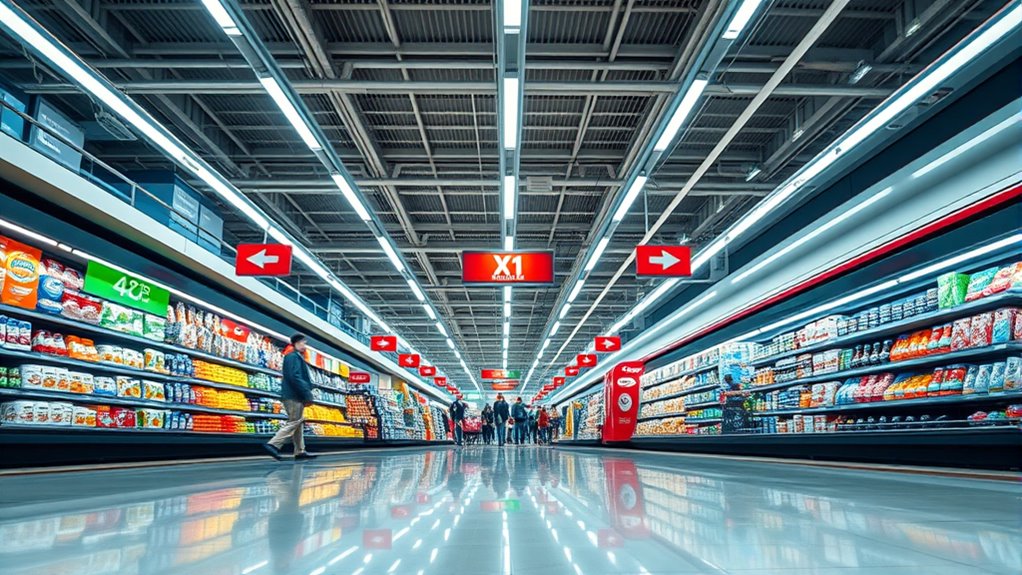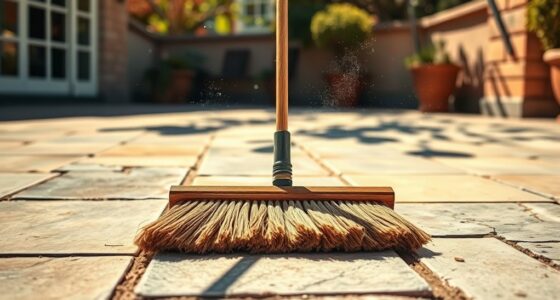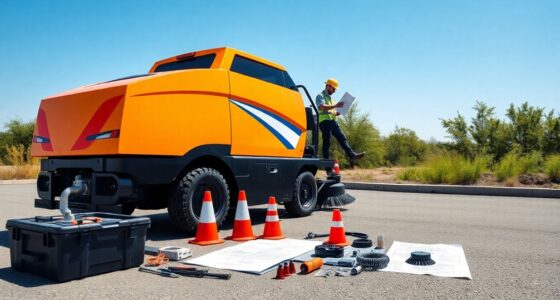To sweep shop aisles faster, you should design straight, parallel lanes that guarantee efficient coverage and minimize overlaps. Place exit points strategically at aisle ends for easy navigation and quick recharging. Allow around 10-15% overlap to avoid missing spots while preventing wasted effort. Proper aisle width and obstacle management also improve robot movement. Keep these tips in mind, and you’ll discover more ways to optimize your cleaning process for faster, more thorough results.
Key Takeaways
- Design straight, parallel aisles to enable efficient robot navigation and reduce cleaning time.
- Optimize overlap levels to ensure thorough coverage without unnecessary repetitions.
- Place clear, unobstructed exits at regular intervals for seamless robot movement and quick return to charging stations.
- Strategically position aisle entrances and exits to minimize detours and streamline cleaning routes.
- Regularly review and adjust aisle layouts based on cleaning patterns to improve efficiency and coverage speed.

Keeping your shop aisles clean and tidy can be time-consuming, but with the right techniques, you can speed up the process considerably. One effective way is to incorporate a robot vacuum into your cleaning routine. These devices are designed to navigate efficiently, saving you hours of manual labor. To maximize their effectiveness, focus on aisle design—creating a layout that facilitates smooth movement for the robot vacuum. Clear obstacles, optimize the placement of shelves, and ensure that aisles are wide enough for the robot to pass through easily. When designing your aisles, think about the flow of traffic and how the robot vacuum will move through the space. This minimizes overlaps and missed spots, making your cleaning more thorough and faster overall.
A key to quick aisle cleaning lies in planning the lanes carefully. Instead of randomly scattered shelving, arrange your aisles in straight, parallel lines. This layout allows the robot vacuum to cover ground systematically without unnecessary overlaps. When aisles are well-aligned, the robot can follow a predictable pattern, reducing the time spent zigzagging or retracing paths. As you set up your aisles, consider the placement of exit points as well. Strategically positioning exits at the end of each aisle ensures the robot vacuum can easily navigate out and into other sections without getting stuck or forced to backtrack. This seamless movement keeps the cleaning process flowing smoothly and minimizes downtime.
Overlap is another essential factor. While some overlap can help ensure no spots are missed, too much results in wasted time and energy. Use the robot vacuum’s mapping features to identify the best overlap percentage—generally around 10-15%. This allows the robot to clean thoroughly without unnecessary repetition. Regularly updating the map, especially after rearranging or adding new shelves, helps maintain efficiency. Also, consider creating dedicated lanes for different types of debris or areas with higher foot traffic, which allows the robot to focus more attention where it’s needed most. Additionally, understanding contrast ratio can help you select the best lighting and layout to make the robot’s sensors work more effectively in your shop environment.
Finally, think about the exit points again. Clear, unobstructed exits at regular intervals prevent the robot vacuum from getting trapped or forced into long detours. If you have multiple aisles, ensure each has a well-marked exit path that connects seamlessly with your overall layout. This way, the robot can complete its task faster and return to its charging station without delays. By combining thoughtful aisle design, strategic lane planning, controlled overlap, and well-placed exit points, you’ll noticeably cut down your cleaning time, leaving your shop spotless and ready for customers with less effort.
Frequently Asked Questions
How Can Technology Improve Aisle Sweeping Efficiency?
Technology can boost your aisle sweeping efficiency by using automated sweepers that navigate with precision, reducing manual effort and ensuring thorough coverage. Pair this with digital scheduling to optimize routes and timing, preventing overlaps and missed spots. These tools help you manage cleaning tasks more effectively, save time, and maintain a cleaner shopping environment. Embracing automation and smart planning makes your aisle sweeping faster and more consistent.
What Are the Best Practices for Training Staff?
You should focus on maintaining training consistency to guarantee all staff understand the best sweeping techniques. Keep staff motivated by recognizing their progress and providing incentives. Use hands-on demonstrations and refresher sessions to reinforce skills regularly. Encourage open communication for questions and feedback. When staff feels valued and well-trained, they’ll sweep aisles faster and more efficiently, improving overall shop cleanliness and customer experience.
How Do Store Layout Changes Impact Aisle Sweeping?
Change in store layout can throw a wrench in your aisle sweeping routine, making it harder to keep things tidy. When aisle design shifts, you need to rethink your sweeping patterns, lanes, and exit points to stay efficient. By adapting your approach to the new layout, you guarantee thorough cleaning, minimize missed spots, and keep the store looking sharp. Flexibility is key to maintaining a smooth, effective sweeping process amid layout changes.
What Safety Protocols Should Be Followed During Sweeping?
You should always wear proper safety gear, like gloves and masks, to safeguard yourself during sweeping. Make sure hazard signage is clearly displayed to alert shoppers about the wet or dusty areas. Keep aisles clear of obstacles to prevent accidents. Always communicate with team members about your sweeping schedule, and never rush, as this can lead to slips or falls. Prioritize safety to ensure a secure environment for everyone.
How Often Should Aisle Sweeping Schedules Be Reviewed?
You should review your cleaning schedules every three to six months to guarantee they stay effective. Regular reviews help identify areas needing improvement and keep staff training current. Investigate the theory that infrequent reviews might lead to outdated practices; this is true. By staying proactive, you ensure your team maintains high safety and cleanliness standards, preventing hazards and boosting efficiency. Regularly updating schedules keeps everyone aligned and prepared for any changes.
Conclusion
By optimizing lanes, overlaps, and exit points, you can truly sweep shop aisles faster. But remember, research shows that well-designed traffic flow isn’t just about efficiency—it’s also about reducing customer stress and increasing satisfaction. When you consider human behavior and how people naturally navigate spaces, you’ll realize that a thoughtful layout can make a significant difference. So, don’t just focus on speed; prioritize a seamless experience, and you’ll find your aisles clear in no time.









